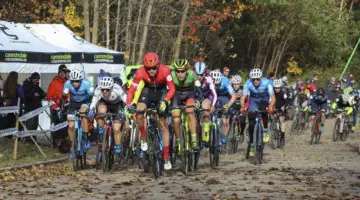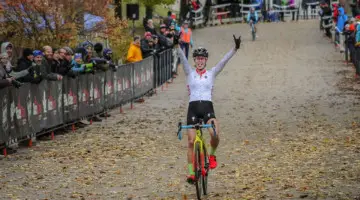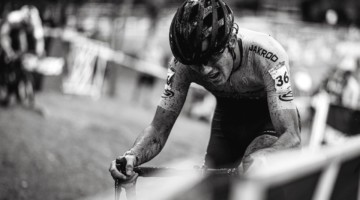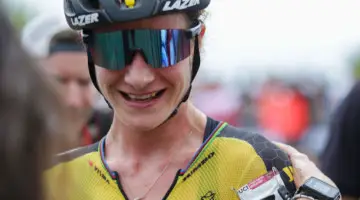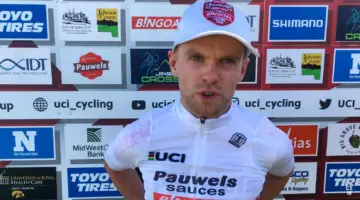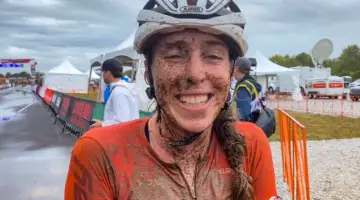In Paul Maunder’s Rainbows in the Mud, the author relates a story of meeting Katie Compton and her partner Mark Legg at Koksijde in 2015. Their van is parked in, one could argue, an insultingly bad spot among juniors and other small teams. Maunder said Compton and Legg shrugged it off; they had bigger things to worry about.
I was reminded of this anecdote last month when I organized to meet up with Compton for a chat on Sunday morning before the Pan-American Championships in Louisville.
A spot in the team tent area for the weekend ran $200+. Always making economical decisions for their KFC Racing p/b Trek/Knight Composites program, Compton and Legg opted for a different parking option.
“We’re in the $15 lot. Look for the trailer.” Compton texted.
When we met up, she joked parking with the amateur racers was being “with the people.”
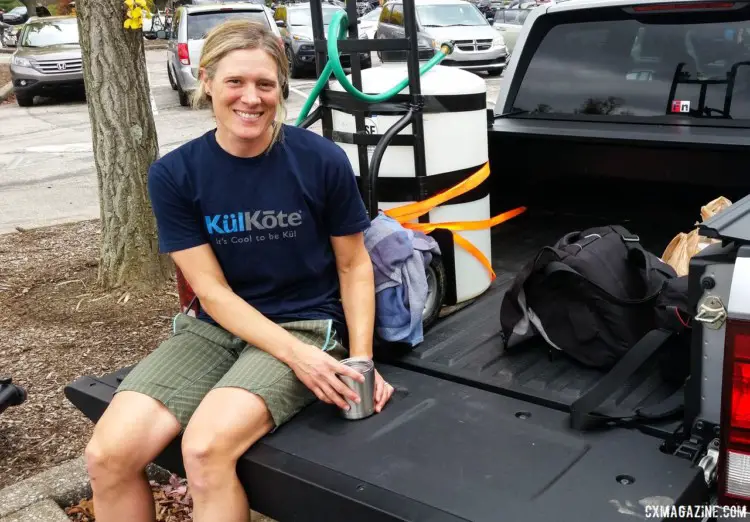
Katie Compton parked her truck “with the people” at the 2017 Pan-American Championships. © Z. Schuster / Cyclocross Magazine
Joking aside, it made sense. Compton has always eschewed frivolity, and she takes her role as a role model for so many women cyclists very seriously. As I learned in our conversation, she was excited to be back home in the U.S. after a month in Europe, so hanging with “the people” was the place to be.
When I sat down with Compton in Louisville, she had just finished her first month of racing a mostly European schedule this season. She was fresh off her epic battle with Helen Wyman on the slopes of the Koppenberg, and she had flown home just to race at Saturday’s Derby City Cup, which she won, and Sunday’s Pan-American Championships.
I am pretty sure I asked for “More than 5 minutes but less than 15.” We ended up talking for 20. Whoops. Fortunately, Compton went on to win on Sunday, so our longer-than-expected interview before she hit the rollers did not significantly impact her racing.
In our chat on the bed of her truck in the lot “with the people,” we talked about the uniqueness of U.S. cyclocross racing, dealing with allergies, racing her #bucketlist races like Zonhoven and Koppenberg, what has made her successful for so long and her improved starts this year.
Interview with Katie Compton at the 2017 Pan-American Championships
Cyclocross Magazine: We’re out here in the parking lot with the people. How has it been the last couple of days being back at home, seeing the American faces and all your fans here?
Katie Compton: Honestly, really good. I flew in Thursday night and then we are staying with friends, so it’s always good to catch up with these guys. Then, yeah, it’s been good. I love U.S. ’cross racing. It’s a little bit simpler than being in Europe and just stressing about parking and logistics for Belgium even though it’s easy once you are there. I don’t know, there’s something nice about U.S. racing I like.
CXM: You’ve been in Europe for the last month and you are back here at Derby City, what about the U.S. experience are you specifically referring to?
KFC: Maybe just the friendly faces that I know. I have met a lot of nice people in Belgium too. The U.S. fans are a little different and I have more friends in the U.S., so that makes it different. The courses are also different too and the venues. Seems like we’re usually parked around people who you can chat with and stuff like that.
CXM: So this course here today at Pan-Ams, lots of climbing, lots of technical. Did it remind you of a Belgium course? What are your feelings about that especially knowing it’s going to be a Nationals course?
KFC: You know, it’s a U.S. course. I was trying to think of the difference between the U.S. and the Belgium courses as I was racing yesterday. There wasn’t one section on the course where you actually came to a slow speed and had to decelerate quickly. Everything is super flowy and swoopy and it’s fun to ride and the descents are really fun and there’s plenty of power sections and good climbing.
At the Belgian races, there is a lot of stop and go, and there are a lot of accelerations, a lot of quick, short power sections, which I’ve noticed we don’t really have that in U.S. I think now that I’m spending more time in Belgium and doing more races, I’m like, “Oh that’s the difference.” It’s speedier, yes. It’s hard too, but there are a lot more accelerations there.
CXM: My team just did a race last week and we tried to put in some more technical features, but when you rode it, it was still fast. Is there a way to achieve that in U.S. courses especially given the way we usually borrow the land and races are at public parks?
KFC: I think the U.S. courses are suited for the amateur fields that have 150 riders. They are not like Belgian courses that have maybe 50 riders, and so you have to make them wider. You have to make them swoopy. You can’t have a ton of switchback, 180-degree turns because then the race is limited to the first five riders and everybody else is kind of waiting to get around the turn.
It’s different, it’s hard for us, I think, to set up the courses similar to Europe. They don’t have to be the same. I just think at the Elite level the difference would be that compared to the more wide-open, just pure pedaling courses in the U.S. it’s a lot more stop and go in Belgium.
You can make the corners higher, you can make more hairpin turns, you can make courses that are kind of more condensed, so it’s a bit more spectator friendly and keeps everything kind of in the same area, which I think would help and it would make everything tighter. Again, it may not suit 150 riders.
CXM: I’ve been at the back of these fields and I hate it.
KFC: It’s awful. Honestly, if you’ve got 150 riders on your field, you should have a wider ’cross course. Cyclocross is about being able to pass. It’s not mountain biking where you are stuck behind 50 people on a single track.
Where in Belgium sometimes you get stuck in a single track and you got to wait a little bit. It’s not a single track, but it rides like a single track. In the U.S. this is what our ’cross is like and there are positives and negatives on both sides of the ocean.
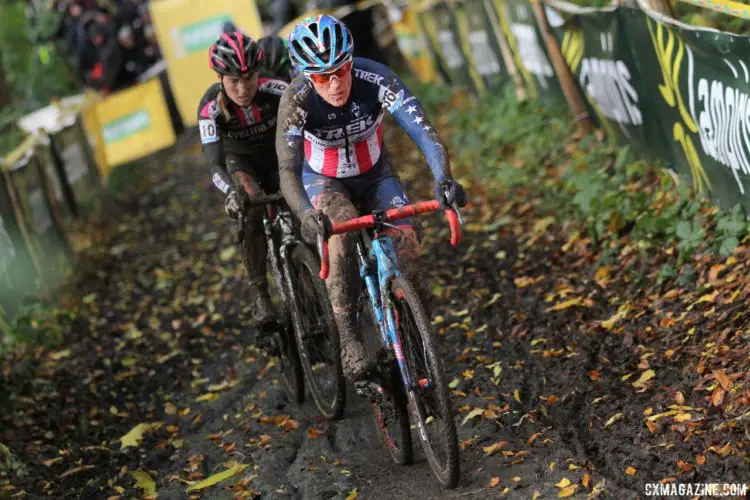
Katie Compton has gotten to experience a lot of different European and U.S. courses this year. 2017 Superprestige Gavere. © B. Hazen / Cyclocross Magazine
CXM: So you have been kind of immersed in ’cross on both continents this year. Do you think it’s kind of silly the way that we try to emulate Belgium and we talk about Belgium in ’cross? Should we celebrate more of the Americanness of what we’ve built here?
KFC: I think when you have a country like Belgium and they have been so good at ’cross for so long, it’s normal to want to emulate that. I feel like when you have someone who’s an expert in a field, following what they do is expected.
They’re good at what they do. I feel like we should emulate some of the Belgian stuff but also embrace the difference in U.S. ’cross racing.
There is no reason why we can’t enjoy two different aspects of ’cross racing and have a U.S.-friendly version as well embrace some of the aspects from Belgium. I feel like U.S. has always been a trendsetter in doing things our own way, and I feel like it’s okay to keep doing things your own way while taking the positives from races in Belgium or World Cup races or those in other areas of the world.
CXM: It seems like there was that positive response from the U.S. World Cups in terms of just the energy throughout the entire field that the world got to experience and they seemed to really enjoy that.
KFC: Yeah. I think that a big part of that is U.S. fans know ’cross racing. They know the riders, they are a fan of the sport and they know what it feels like to race, where a lot of Belgian fans are fans but they don’t really race ’cross.
They ride a bike, most everybody rides a bike in Europe. It’s a different crowd from a community riding bikes to people actually in the thick of it racing and you know what it feels like to suffer up a climb to race for the 50th spot or dive-bomb a turn as you pass three people.
It’s a different feeling with the U.S. fans. It feels good. The European fans are getting louder and they are cheering more, and they’re coming out more I think.
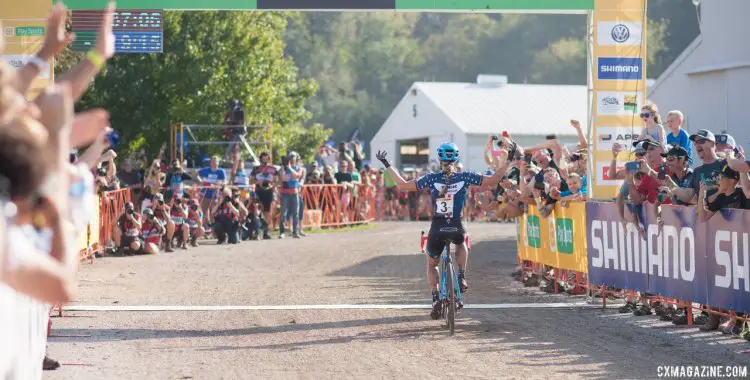
Compton has received a lot of support from U.S. fans during the American World Cups the past three years. 2016 Jingle Cross cyclocross festival. © A. Yee / Cyclocross Magazine
CXM: You never really have a problem with being 50th, except it seems like the only thing that can really defeat you right now is allergies. How have you been getting through that? It seems like it has to be frustrating dealing with that for so long.
KFC: When I was in my 20s, I could eat whatever I wanted. I didn’t have any allergies and I was like what do you mean allergies? What is that? Do you have any idea?
Every year it’s gotten progressively worse and part of that is due to, I don’t want to say it, a little bit of climate change possibly? The increase in CO2 levels in the air makes plants and trees and everything grow more, so if everyone is having issues with seasonal allergies and it’s getting worse every year, we can blame high CO2 levels.
CXM: Haha, I did my PhD research on climate change, so I hear you.
KFC: That’s science right there. Whether you believe science or not, I believe science. I think that’s part of it.
For me, I’ve got a grass and a weed allergy, so I’m also allergic to leaves and mold and everything that’s outside, which is annoying. I figured out rice is a grass family, and so I think when I’m in an area that has grass and weed and especially in Belgium, when they just cut the grass in the fields, any little bit I ingest, it just makes it worse.
I actually cut out rice and I wasn’t eating much of it, but just a little bit here and there. It affects me and I feel really bad when I eat it, so I stopped eating that at Koksijde. I pre-rode the course and I could barely breathe. I realized I had an energy bar that had a rice-flour base and I felt awful within 30 minutes.
CXM: Oh, wow.
KFC: And it got worse and worse, and I was like, “Huh. I wonder what … what is that?” Then I was kind of researching it a bit, and I was like, ah grass family. That’s me.
I know what I can do, and I know what affects me, and if it affects my performance and my paycheck because if I am not getting results, I am not getting bonus money, I am not getting price money, and I’ve got to figure out a way to fix it.
I’ve been really on top of my nutrition and knowing what I can and can’t eat, and making sure I get the right amount of macronutrients and micronutrients. Right now, I am doing well, and the asthma’s under control, allergies were fine yesterday. Louisville is actually one of top spots in the country for allergies.
CXM: Really?
KFC: Yeah, isn’t that awesome.
CXM: Along those lines, our other contributor here is 25 and we were watching some of what he eats and were like “Dude, trust me. I am 35, it’s a good time to start taking care of yourself.”
KFC: Honestly, you don’t notice it when you are in your 20s. You can get away with so much, but every year it just gets harder and harder. I’m 38, I will be 39 in December and I notice the difference.
I am getting smarter, I am definitely managing my efforts and I am getting smarter, but I’m also really on top of what my body can do and staying present and seeing how I feel each day. I’m like, “All right, what can my body do for me today? How am I feeling, how am I breathing?” And then, I kind of adapt the training to try and compensate for the lack of energy. I’ve got a ton of energy …
CXM: I know. I saw your race yesterday, and you had a lot of energy.
KFC: Yeah, that was fun. I am hoping I didn’t burn matches yesterday. I always think, “Yeah, I’ve got this under control,” but sometimes the next day I just, I spent too much energy on the course most of the times.
CXM: Part of your trip is all the bucket list races you’ve gotten to do, One after another on that list. How has that been?
KFC: It was awesome. At Zonhoven I had some spots where I couldn’t breathe again, but it was fun. Man, that race was so fun, dropping into The Pit, the big sand pit. The video and photos don’t do it justice because it’s a lot steeper and longer than it looks.
The sand is probably, it’s at least a foot deep. It is so fun because it’s kind of like skiing powder. Instead of keeping your tips up, you just keep the front end up a bit. You try to pedal, speed through it and just let it go. Hell, it’s so fun and the crowd is crazy.
I really enjoyed the race. Physically it sucked, but like mentally and emotionally, I was just like, “This is the coolest thing ever.” I wish I could start again.
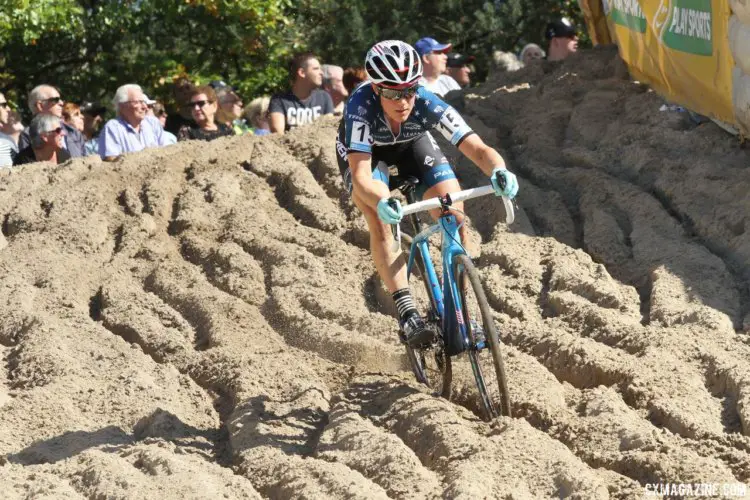
Despite health issues, Compton still had fun at the 2017 Superprestige Zonhoven. © B. Hazen / Cyclocross Magazine
Then Koppenberg, that was just a brutal course in general, and, I mean, the cobble climb was the hard part, but everything else was harder.
The cobbles are just hard for about ten seconds in an eight-minute lap. I was happy with that because I haven’t been climbing since I left Colorado in September. For me to have a good climbing day, well maybe it wasn’t great, but it was good enough. And then the descent, it wasn’t a ton of descending, but it was enough, so it was really fun.
CXM: Yeah, I feel like last year maybe there is more descending and the climb was different because you climbed in the grass and then finished on the cobbles. It was cool that they’re changing it up instead of running the same the circuit every year.
KFC: Yeah, they are really changing it up because a farmer wasn’t going to let them use their land this year. I think that’s what it was, and so when you look at the Koppenberg, the course is usually is on the left of the Koppenberg climb. This time it was all on the right side of the course.
CXM: Gotcha.
KFC: We started at the bottom, and it’s a long stretch from the bottom of the Koppenberg to the top. We started at the bottom but they put the finish line at the very top. The point where you want to go downshift and start accelerating, that’s where they put the finish line. You had to work pretty hard the whole time.
The descent was, I mean it was good, it was just tough because I think they just moved the cows off the pasture that day or the day before because it was full of like cow holes and cow patties. You kind of had to maneuver around the cow piles.
CXM: Well, when I think of field riding, I think of Koppenberg.
KFC: You are field riding. There is a lot of field riding, literally field riding.
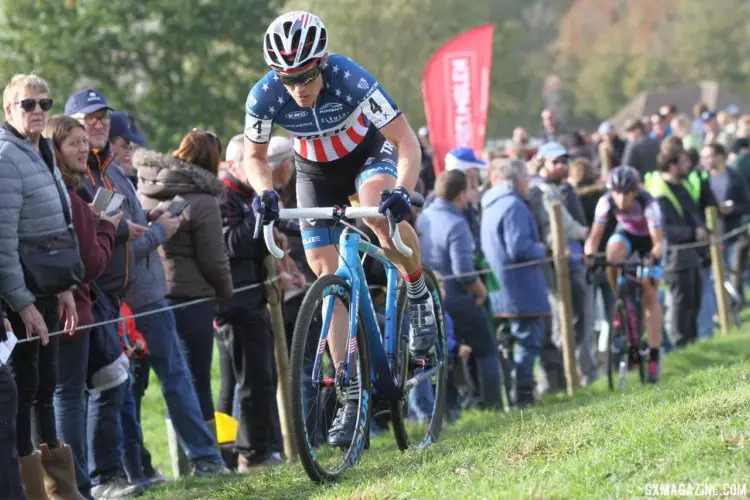
Compton had a memorable battle against Helen Wyman at the 2017 Women’s Koppenbergcross. © B. Hazen / Cyclocross Magazine
CXM: You’re at these iconic races and how do you balance that with the fact that you’re still going to earn a paycheck and race your bike. You’re just smiling the whole time?
KFC: I was really enjoying it. I don’t actually think about bonus money and earning a paycheck. I just think about how this is the coolest thing. I am super happy to be racing today. Getting the experience, because how many people don’t get that experience? It’s pretty cool.
I’ve just been really trying to enjoy the races and enjoy the moments. Even on my bad days, I’m just trying to focus on, “Okay, what am I doing well? What can I be positive about?”
I’ve had some ups and downs in the last two or three years or even four years of racing where now I am to the point where I’ve gotten really good results, I’ve persevered a lot with health issues and now I am just like, “I’m out here, still doing it, I’m still getting results. I am going to enjoy the racing and lining up on the start line,” because I’m pretty sure now I’m at the countdown of my career.
CXM: No, don’t say that!
KFC: I don’t know how many more seasons I’m going to be able to do it. I want to enjoy every race I do until I decide to stop. Ten years ago, obviously, it was like, “Oh, I have got so many years in front of me.” Now, I am just thinking like, “Not too many more years.”
CXM: Back when we talked in January you were saying that you were still having fun and were excited Trek was having a World Cup, even though it wasn’t so great…
KFC: Trek was awful!
CXM: That race happened, and then you got to do these bucket list races, I figure you’re still finding some excitement in racing?
KFC: I love racing my bike. It’s funny because every race I have done this year I’m like “I am really excited to go race my bike today.” I am on the start line and I am really excited to do this. I really want to do it.
Whereas a couple of years ago with health issues, I’d have been like “I don’t know about this, maybe I should retire?” I was working really hard to get like 12th.
I feel like as a racer it’s almost good to have these bad seasons. It’s good to struggle, it’s good to work really hard and not get the results you want. It really means you appreciate winning when you do win because I put the same amount of work into it whether I am winning or whether I am 20th. I’m working my ass off in training, I’m resting and trying to do it right.
It’s like when everyone is saying “Oh, if you just work hard enough it’s going to pay off,” I am like, “Bullshit.” Every one of us works really flippin’ hard. It works out for some people and some people it doesn’t. It’s just like you have to accept the fact that sometimes it doesn’t work out and then really enjoy the days that it does.
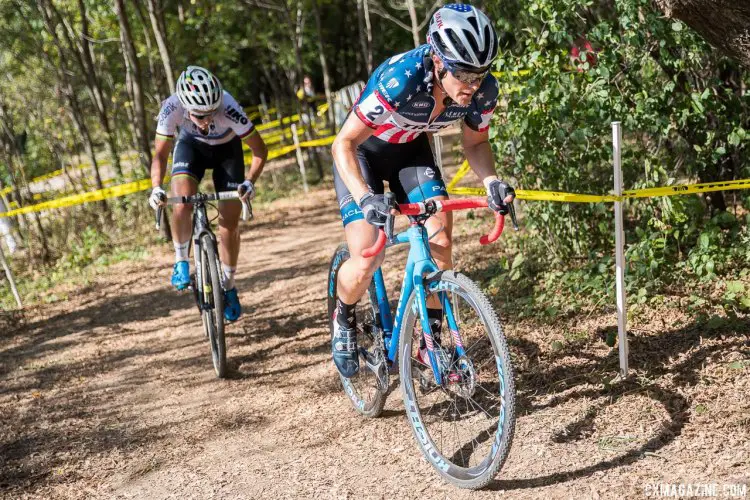
Despite a rough World Cup in Waterloo, Compton still got a win against Sanne Cant on Friday at the 2017 Trek CX Cup, Friday UCI C2. © J. Curtes / Cyclocross Magazine
CXM: Well, I said like 8 minutes and it’s been 15. Is it okay if I ask you two more questions?
KFC: Okay.
CXM: You are too kind. So we all work hard, either at the amateur level or the professional level. What is it that you do that provides you with that edge that brings you 13 national titles and 127,000 UCI wins and all that?
KFC: 126, maybe 127, I don’t know.
CXM: When someone is reading this, what are, especially from an amateur’s perspective, what are the things that you do that put you over the top?
KFC: I don’t get wound up about stuff. Yes, I have dealt with a lot of stress but I learned how to manage it. I try to be relaxed. I don’t let things get to me. Yes, I do right with my nutrition, I focus on my rest and my sleep and make sure the training is quality, not quantity.
I am not going to go out and do three hours of intervals if I wake up, and half an hour on the bike I feel my power is too low. I feel awful, I can’t breathe. I am like, “Okay, today is not the day to do it.” Now I don’t push myself. You know what, tomorrow will probably be better and sure enough, it usually is. I pick and choose the days I go hard which I think that comes with experience and knowing your body. I think that has helped me at times.
I know my body, I know what it can do. I think I’m just smart at training and then just the rest, recovery and not being too hard on myself. There are plenty of years every bike racer has, where you’re like shoot, you want to be better and so you constantly push push push.
Where, in reality, maybe you need to rest. Maybe you need to sleep longer. Maybe you’d do better if you had gotten ten hours of sleep last night instead of getting up after six hours and trying to do intervals on the trainer before you go to work.
I think people underestimate how much sleep makes a difference in your recovery and how you feel and your moods and your energy levels. For me, I think making sure I get the recovery in and listen to my body. I think that’s what I learned the most.
And just having good mental perspective on things. I don’t take myself too seriously. Take the job seriously but for me, I don’t take myself very seriously, so I think that helps.
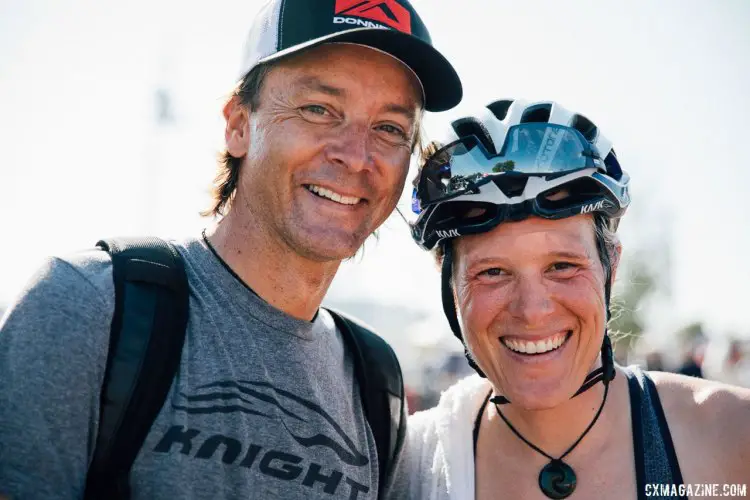
Katie Compton takes racing seriously but never takes herself too seriously. Here, with partner Mark Legg. 2017 Trek CX Cup, Friday UCI C2. © J. Curtes / Cyclocross Magazine
CXM: My final question is actually specific to the racing. We talked last January, and I know I bonded with you because you talked about your slow starts. Especially in the DVV races, Maud Kaptheijns has been blowing the starts out of the water. You’ve been there though. It seems like you’re changing your racing style a bit. Has that an adjustment or a necessity and it seems like you’ve really kind of worked hard to make your starts better this year?
KFC: Yes, it’s a necessity because I had so many bad starts for the last couple of years. I used to be a really good starter. In the last few years, I haven’t been starting well, mostly because of health issues that haven’t allowed me to really train on my start.
This year, I was so tired of having bad starts. I worked on my sprint. I worked on my starts. Pretty much every single day I get on my bike this year. I did at least one start, whether it’s a max start, whether it’s kind of a moderate level, just hitting the pedal with the right timing. I just worked on it and obviously that’s helped. I mean, it was there. It was a matter of being healthy and practicing more and then making sure my cleats and pedals are lined up properly because if your cleat’s not in the right spot you can miss your pedal pretty easily.
It’s just practice. It’s something I needed to work on and I did. I feel much better. It’s so much easier getting it to work. I’m like, this is what it’s like to get a good start and then just rest, and then go again. Instead of getting a bad start, working really, really hard to still be in 20th and then you’ve still got to make all the time up.
I’ve definitely worked on those, and it’s paid off.
CXM: Cool, and so then finally, you’re here at Pan-Ams, are you bouncing straight after this? You’ve got two World Cups coming up, so is it the World Cups and then we will be seeing you on live streams for the rest of the season?
KFC: Yes. I leave to go back to Belgium on Tuesday. I’ll race at the Gavere Superprestige on Sunday, which is a race I’ve won four times. I love the race, it’s super fun. Then we go to Denmark for the World Cup and Zeven for the next World Cup and then I’ll race Hamme, which is another DVV on Sunday after Zeven.
Yeah, I will be in all the DVV series of races for the rest of the season. And there’s the live streaming, which I think is great because you can get up in the morning, have your coffee, watch the Women’s race, watch the Men’s race and then start your day. Yeah, check out the live streaming, it’s been a really good racing. Women’s races have been really exciting this year.
CXM: Yeah.
KFC: It’s a different winner, different podium every race. Check it out.
CXM: There have been some Stars-and-Stripes infiltrating those European podiums.
KFC: Yes. Yes. And honestly, it’s been fun to be over there because I feel like I’m finally more welcome and kind of getting included more in the racing bit. I think it helps to be over there actually doing it instead of just popping in here and there for the races.
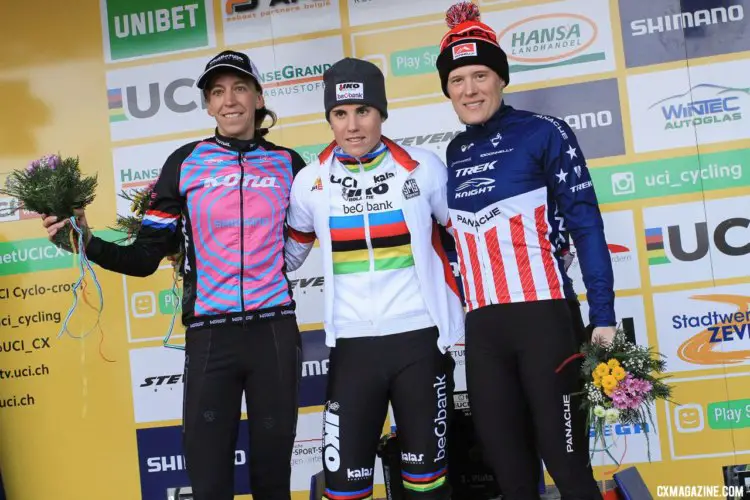
Compton’s Stars-and-Stripes kit has made several Euro podiums this year. 2017 World Cup Zeven. © B. Hazen / Cyclocross Magazine
CXM: Cool. Well, thank you for your time.
KFC: Cool, no problem.
CXM: I appreciate it. Good luck today.
KFC: Thank you.























